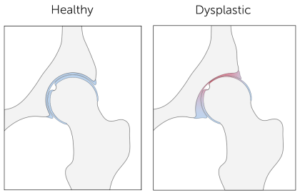
Hip dysplasia in adults is a condition where the hip socket (acetabulum) is shallower than normal with the result that the ball (femoral head) can move around more easily in the hip socket.
For us yogis this can present a bit of a quandary. Hip dysplasia usually offers greater range of motion in the hips which makes those glorious “open-hip” poses more accessible. But it also means that the hip is less stable and at higher risk of damage from things like labrum tears or more susceptible to early arthritis. Achieving success in a bendy pose is exciting, but we yogis need to be careful about glorifying our hyper mobility and perhaps begin to consider super flexible hips as more of a warning signal.
Most people with hip dysplasia are born with it but the symptoms of HD often don’t show up until adulthood. If you are a super mobile person or if you already know that you have HD then it’s worth taking steps to prolong the life of your hips before an intervention like total hip replacement is necessary by starting with sound yoga technique.
Follow these rules of thumb for the safety of hip dysplasia, for Total Hip Replacement, or for the health of your hips in general!
– Move into stretches from a place of strength and be careful when you use your arm strength or “leverage” to pull yourself deeper into a pose. For instance, in a seated pose like paschimottanasana (seated forward fold), first, use your core strength to bring your body closer to your legs, and second, use your arms to pull using minimal strength.
– Gravity applies powerful leverage to the body. Instead of “falling” into a pose like uttanasana (standing forward fold) use your strength control your descent as you “move” into the pose. Being in control of your movements allows you you to watch more intently how your body is responding and to stop before it is too late.
– If you are very mobile, scale back your range of motion and opt for a more modest form of the pose. Remember yoga is not about the goal but the journey!
– If you are practicing restorative poses, prop yourself so that you are not in your deepest stretch. And never stay for long periods in an extremely stretched position.
Learn Yoga Basics for the health and safety of hips here:
Yoga Basics Preview – Non-members
Yoga Basics – Members
Become a Yoga for Hip Replacement member here
If you have had a total hip replacement, and if you had hip dysplasia before your surgery, you may find that your hip is not as mobile as before your surgery because the new prosthesis has a more “normal” ball and socket joint. Take this as an opportunity. It takes time to get to know new hips. Enjoy the journey!
Signs of hip dysplasia
If you have not had X-rays to confirm if you have HD, then you could watch for these indicators:
– Pain in the groin that increases with activity
– A catching, snapping or popping sensation
– Loss of range of motion in the hip
– Difficulty sleeping on the hip
– Loose or unstable hip joint.
– Limping when walking.
– Unequal leg lengths.
Articles and Studies:
International Hip Dysplasia Institute
Hip Joint Replacement Surgery for Hip Dysplasia
Hip Dysplasia (Cleveland Clinic)
Hip Dysplasia – Yoga Exercises and Diet
How to Avoid Destroying Your Hips in Yoga
